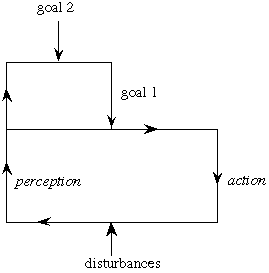For example, your primary goal of survival entails the lower order goal of maintaining sufficient hydration, which may activate the goal of drinking a glass of water. This will in turn activate the goal of bringing the glass to your lips. At the lowest level, this entails the goal of keeping your hand steady without spilling water.
Such hierarchical control can be represented in terms of the control scheme by adding another layer, as in Fig. The original goal 1 has now itself become the result of an action, taken to achieve the higher level goal 2. For example, the thermostat's goal of keeping the temperature at its set-point can be subordinated to the higher order goal of keeping the temperature pleasant to the people present without wasting fuel. This can be implemented by adding an infrared sensor that perceives whether there are people present in the room, and if so, then setting the thermostat at a higher temperature T1, otherwise setting it to the lower temperature T2. Such control layers can be added arbitrarily by making the goal at level n dependent on the action at level n + 1.
 Fig. : a hierarchical control system with two control levels
Fig. : a hierarchical control system with two control levels
A control loop will reduce the variety of perturbations, but it will in general not be able to eliminate all variation. Adding a control loop on top of the original loop may eliminate the residual variety, but if that is not sufficient, another hierarchical level may be needed. The required number of levels therefore depends on the regulatory ability of the individual control loops: the weaker that ability, the more hierarchy is needed. This is Aulin's law of requisite hierarchy. On the other hand, increasing the number of levels has a negative effect on the overall regulatory ability, since the more levels the perception and action signals have to pass through, the more they are likely to suffer from noise, corruption, or delays. Therefore, if possible, it is best to maximize the regulatory ability of a single layer, and thus minimize the number of requisite layers. This principle has important applications for social organizations, which have a tendency to multiply the number of bureaucratic levels. The present trend towards the flattening of hierarchies can be explained by the increasing regulatory abilities of individuals and organizations, due to better education, management and technological support.
Still, when the variety becomes really too great for one regulator, a higher control level must appear to allow further progress. We call this process a metasystem transition, and propose it as a basic unit, or "quantum", of the evolution of cybernetic systems. It is responsible for the increasing functional complexity which characterizes such fundamental developments as the origins of life, multicellular organisms, the nervous system, learning, and human culture.
Reference:
Heylighen F. & Joslyn C. (2001): "Cybernetics and Second Order Cybernetics", in: R.A. Meyers (ed.), Encyclopedia of Physical Science & Technology , Vol. 4 (3rd ed.), (Academic Press, New York), p. 155-170

